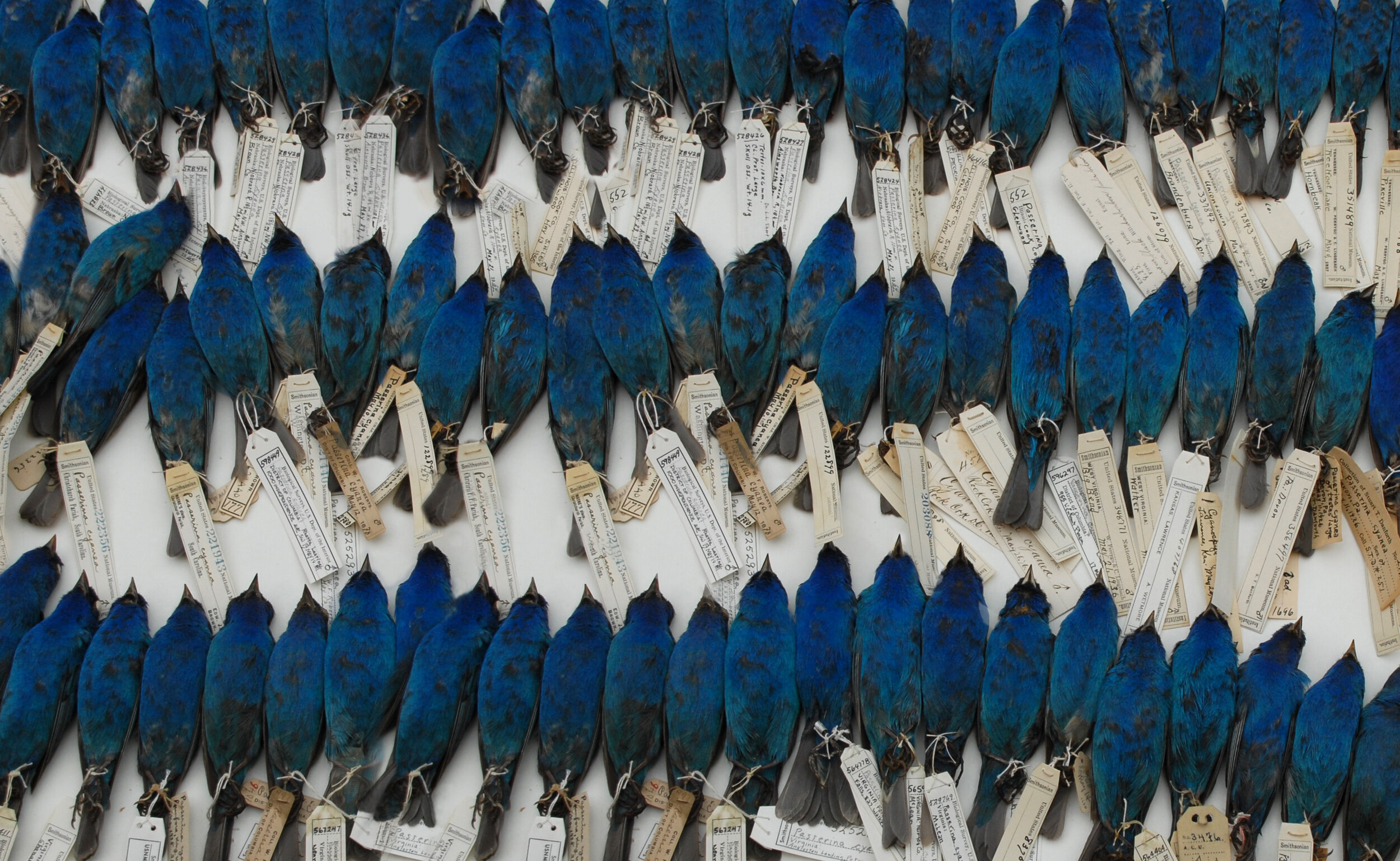
Blue
Blue, an ongoing project, is based on the premise that a tiny songbird, the sky, and crystal all share one particular trait: the ability to generate structural blue. My interest in structural color began several years ago while researching songbird migrations. I discovered the blue in songbird feathers is caused by a unique physical process; what physicists call physical light or structural color. Structural color is not created by pigment, but through the manipulation of light spectra, also known as light scattering. This is the stuff of nature, nano-technology, and alchemy. The nanostructure within a bird’s feather transmits the same information (physical light) that is the blue of the sky. This is the essence of its material.
Cyanometer
Fallout
Orientation Cage
The Light That Got Lost
Indigo Scroll
The Shape of Blue
Cyanometer
Horace Benedict de Saussure and Alexander Von Humboldt created the first cyanometer with painted paper in 1789 to measure the blue of the sky at different altitudes during an ascent of Mont Blanc.
I cast a cyanometer out of opalescent glass - manipulated through a heating process that transforms it from an amorphous solid into a partially crystallized state capable of causing light scattering that creates the blue of the sky. Different values of blue reflect from within the cast glass form in direct response to light and the degree to which the glass has crystallized. In contrast, yellows and oranges are transmitted as light passes through the glass, just as the sky does at sunrise and sunset.
Cyanometer
2020 Cyanometer generating the blue of the sky from within.
Cyanometer: Cloud Drawing
2020
Taking my cyanometer outside where it generates sky blue from within, while also reflecting the sky and clouds on its surface.
Fallout
Migration Fallout is a term used to describe the sudden drop/landing of migrating songbirds in response to severe conditions. In this series I have slumped opalescent glass over stacks of cast songbird bodies. Slumping is a process of melting sheets of glass over a mold. Through a process of controlled temperature/timing the glass stops mid-flow, maintaining a sense of movement in contrast to the static positions of the songbird bodies. The bird bodies are concealed and revealed within the flow of the glass generating a simultaneous sense of presence and absence, alive and not. At the same time, the opalescence of the glass is responding to light, reflecting blue and transmitting yellows/oranges.
Orientation Cage
Orientation cages are used to study the navigation methods of migratory songbirds. The funnel-shaped cages are configured to alter a migrating bird’s perception of the stars, the Sun, the Moon, and even the Earth’s magnetic field.
Casting the orientation cage out of solid opalescent crystal causes it embody an entire day; reflecting the blue of day while also transmitting the reds/oranges of sunrise and sunset.
Orientation Cage 2014 - 2018
Dimensions 18” D X 8” H
Materials: Solid cast opalescent crystal orientation cage.
The Light That Got Lost
The Pastel rubbings were taken directly from songbird bodies. Rubbing pastel on thin rice paper over the bodies of songbirds, creates a surprisingly life like impression.
The Light That Got Lost
2012-15
Dimensions variable
Rice paper, pastel, magnets, steel
Indigo Scroll
These study skins are Indigo Buntings, Passerina cyanea stored within a natural history collection. Even in death their feathers are an intense blue; the result of organized light scattering. Indigo Buntings were the first migratory birds to be studied within the funnel shaped orientation cages devised by Stephen Emlen in 1966. Those studies proved that Indigo buntings, a nighttime migrator, use celestial cues to navigate during migration.
Indigo Scroll
2016
Dimensions: 120” X 18”
Photograph of Indigo Bunting study skins printed on fabric, light, mounted on plexiglass, metal.








The Shape of Blue (Day)
The Shape of Blue consists of two solid cast cobalt crystal spheres; one is a light blue - Day, and the other dark blue - Night. Each has a smooth exterior. In contrast, deep within the material are the negative impressions of songbird bodies which create a topographical surface. When seen through the solid crystal walls, the intensity of the blue is lighter or darker in response to the depth/height of its topography.
The Shape of Blue (Day)
2015 - ongoing
21” diameter Cast Cobalt Crystal
The Shape of Blue (Night)
Solid cast cobalt crystal sphere containing the negative impression of songbird bodies. Some impressions are closer to the surface and some are farther away. The crystal is intensely dark in some areas, obscuring the bird body impressions within. At other points the impressions are closer to the surface, revealing the bird body impressions through the crystal material.
The Shape of Blue (Night)
2015 - ongoing
21” Diameter Cast Cobalt Crystal
Magnetism 2017 Dimensions: 20” H X 15” W Lodestones, iron filings, photograph of the sky

























